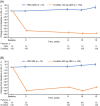Randomized study of evolocumab in patients with type 2 diabetes and dyslipidaemia on background statin: Pre-specified analysis of the Chinese population from the BERSON clinical trial
- PMID: 30851062
- PMCID: PMC6594089
- DOI: 10.1111/dom.13700
Randomized study of evolocumab in patients with type 2 diabetes and dyslipidaemia on background statin: Pre-specified analysis of the Chinese population from the BERSON clinical trial
Abstract
Aim: The aim of this study was to evaluate the efficacy and safety of evolocumab with background atorvastatin in Chinese patients with type 2 diabetes mellitus (T2DM) and hyperlipidaemia or mixed dyslipidaemia.
Materials and methods: This is a pre-specified analysis of patients in the BERSON study (ClinicalTrials.gov, NCT02662569) in China. Patients initiated background atorvastatin 20 mg/d, after which they were randomized 2:2:1:1 to evolocumab 140 mg every 2 weeks (Q2W) or 420 mg monthly (QM) or to placebo Q2W or QM. Co-primary endpoints were percentage change in LDL cholesterol (LDL-C) from baseline to week 12 and from baseline to the mean of weeks 10 and 12. Additional endpoints included atherogenic lipids, glycaemic measures and adverse events (AEs).
Results: Among 453 patients randomized in China, 451 received at least one dose of study drug (evolocumab or placebo). Evolocumab significantly reduced LDL-C compared with placebo at week 12 (Q2W, -85.0%; QM, -74.8%) and at the mean of weeks 10 and 12 (Q2W, -80.4%; QM, -81.0%) (adjusted P < 0.0001 for all) when administered with background atorvastatin. Non-HDL-C, ApoB100, total cholesterol, Lp(a), triglycerides, HDL-C and VLDL-C significantly improved with evolocumab vs placebo. No new safety findings were observed with evolocumab. The incidence of diabetes AEs was higher with evolocumab compared with placebo. There were no differences over time between evolocumab and placebo in measures of glycaemic control.
Conclusions: In patients in China with T2DM and hyperlipidaemia or mixed dyslipidaemia receiving background atorvastatin, evolocumab significantly reduced LDL-C and other atherogenic lipids, was well tolerated, and had no notable impact on glycaemic measures.
Keywords: dyslipidaemia; evolocumab; hyperlipidaemia; phase 3; type 2 diabetes.
© 2019 The Authors. Diabetes, Obesity and Metabolism published by John Wiley & Sons Ltd.
Conflict of interest statement
F. G. E. has served as a speaker for and has received grants for research from Amgen Inc., Sanofi, Boehringer, Eli Lilly, Novo Nordisk and AstraZeneca. A. J. L. has served as an advisory board and steering committee member for and has received research grants and speaker fees from Amgen Inc. M. L. M., N. W. and A. W. H. are employed by and own stock in Amgen Inc. Y. C., Z. Y., J. L. and J. G. have no conflicts of interest to disclose.
Figures



Similar articles
-
Randomised study of evolocumab in patients with type 2 diabetes and dyslipidaemia on background statin: Primary results of the BERSON clinical trial.Diabetes Obes Metab. 2019 Jun;21(6):1455-1463. doi: 10.1111/dom.13680. Epub 2019 Apr 2. Diabetes Obes Metab. 2019. PMID: 30821053 Free PMC article. Clinical Trial.
-
Effects of evolocumab in individuals with type 2 diabetes with and without atherogenic dyslipidemia: An analysis from BANTING and BERSON.Cardiovasc Diabetol. 2021 Apr 30;20(1):94. doi: 10.1186/s12933-021-01287-6. Cardiovasc Diabetol. 2021. PMID: 33941192 Free PMC article.
-
Efficacy and safety of evolocumab in individuals with type 2 diabetes mellitus: primary results of the randomised controlled BANTING study.Diabetologia. 2019 Jun;62(6):948-958. doi: 10.1007/s00125-019-4856-7. Epub 2019 Apr 5. Diabetologia. 2019. PMID: 30953107 Free PMC article. Clinical Trial.
-
Beyond low-density lipoprotein: addressing the atherogenic lipid triad in type 2 diabetes mellitus and the metabolic syndrome.Am J Cardiovasc Drugs. 2005;5(6):379-87. doi: 10.2165/00129784-200505060-00005. Am J Cardiovasc Drugs. 2005. PMID: 16259526 Review.
-
Managing the residual cardiovascular disease risk associated with HDL-cholesterol and triglycerides in statin-treated patients: a clinical update.Nutr Metab Cardiovasc Dis. 2013 Sep;23(9):799-807. doi: 10.1016/j.numecd.2013.05.002. Epub 2013 Aug 9. Nutr Metab Cardiovasc Dis. 2013. PMID: 23932901 Review.
Cited by
-
Clinical Evaluation Of Evolocumab For The Treatment Of Homozygous Familial Hypercholesterolemia In Chinese Patients.Ther Clin Risk Manag. 2019 Oct 15;15:1209-1216. doi: 10.2147/TCRM.S193971. eCollection 2019. Ther Clin Risk Manag. 2019. PMID: 31686828 Free PMC article. Review.
-
Effects of evolocumab therapy and low LDL-C levels on vitamin E and steroid hormones in Chinese and global patients with type 2 diabetes.Endocrinol Diabetes Metab. 2020 Mar 6;3(2):e00123. doi: 10.1002/edm2.123. eCollection 2020 Apr. Endocrinol Diabetes Metab. 2020. PMID: 32318641 Free PMC article.
-
Sex Differences in Cardiovascular Outcomes and Cholesterol-Lowering Efficacy of PCSK9 Inhibitors: Systematic Review and Meta-Analysis.JACC Adv. 2023 Oct 28;2(9):100669. doi: 10.1016/j.jacadv.2023.100669. eCollection 2023 Nov. JACC Adv. 2023. PMID: 38938736 Free PMC article.
-
Chinese expert consensus on blood lipid management in patients with diabetes (2024 edition).J Transl Int Med. 2024 Oct 1;12(4):325-343. doi: 10.2478/jtim-2024-0014. eCollection 2024 Sep. J Transl Int Med. 2024. PMID: 39360162 Free PMC article.
-
PCSK9 Inhibition: New Treatment Options and Perspectives to Lower Atherogenic Lipoprotein Particles and Cardiovascular Risk.Curr Atheroscler Rep. 2019 Jul 27;21(10):40. doi: 10.1007/s11883-019-0802-x. Curr Atheroscler Rep. 2019. PMID: 31350672 Review.
References
-
- International Diabetes Federation . IDF Diabetes Atlas. 8th ed.: The Atlas; 2017. http://www.idf.org. Accessed April 3, 2019.
Publication types
MeSH terms
Substances
Associated data
LinkOut - more resources
Full Text Sources
Medical
Miscellaneous

